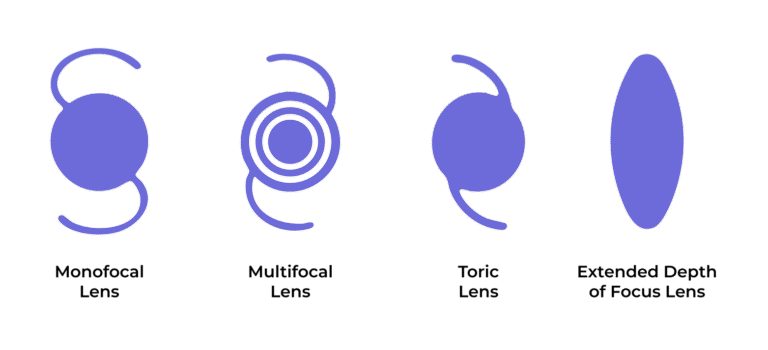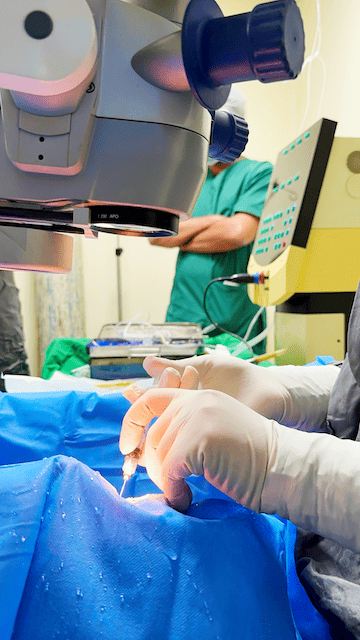Every Patient Deserves to See the World in its True Colours Again
What is Cataract (MOTIA)?
A cataract is the clouding of the eye’s natural lens, making vision blurry or hazy. Cataracts are the leading cause of blindness worldwide, responsible for nearly 51% of global cases. In Pakistan, they account for more than 40% of blindness. The good news: cataract can be safely treated with surgery.
Cataract treatment/surgery is the most common and one of the safest procedures worldwide.
Symptoms:
- Blurred vision
- Faded colors
- Glare at night
- Double vision in one eye
- Light sensitivity or halos
Myths: Cataract cannot be reversed with diet or medicine, it only causes visual symptoms, not pain or redness.
Causes & Risk Factors of Cataract
Cataract can develop faster in people with diabetes or those exposed to excessive sunlight without eye protection. Additionally:
- Excessive UV Light Exposure
- Smoking
- Excessive Alcohol Use
- Nutritional Deficiencies
- Eye Surgery or Inflammation
- Radiation Exposure
- Obesity & Hypertension
Treatment of Cataract
The only effective treatment for cataracts is surgery, which involves removing the cloudy natural lens and replacing it with a clear, artificial intraocular lens (IOL). Cataract surgery is the most common eye procedure performed worldwide and has an excellent safety record. With advanced technology, patients can now choose from different lens options tailored to their lifestyle and vision needs.
Choosing the right intraocular lens (IOL) during cataract surgery is an important step in achieving your best vision:
- Monofocal IOL:Focuses at a single distance, usually for far vision. Glasses may be required for reading or intermediate tasks. Ideal for those prioritizing clear distance vision.
- Presbyopia-Correcting IOLs (Multifocal/Trifocal):Correct vision at near, mid-range, and distance, reducing reliance on glasses. A great choice for active individuals who prefer visual freedom in everyday tasks.
- Toric IOL:Designed to correct astigmatism and reduce distortion. Recommended for patients with moderate to high cylindrical prescriptions seeking sharp, clear results.
- Edof IOL (Extended Depth of Focus Lens):EDOF IOLs provide a continuous range of clear vision, especially from distance to intermediate (such as driving, using a computer, or cooking).

What to Expect Before, During, and After?
Cataract removal is an elective procedure, typically recommended when daily tasks such as driving or reading become challenging. If both eyes are affected, surgery is performed on separate days.
How Surgery is Performed?
- Outpatient procedure lasting 15–20 minutes.
- Numbing drops and mild sedatives ensure a pain-free, relaxed experience.
Risks
- Temporary discomfort, swelling, or increased eye pressure.
- Rare risks: infection, bleeding, or lens opacification (treated with a quick laser)
Post Op Recovery & Care
- Blurred vision or irritation for 1–7 days.
- Avoid dust, makeup, soap (1 week)
- Avoid bending, heavy lifting, swimming, and eye rubbing (2 weeks)
- Follow-ups: 1 day, 1 week, 1 month.
The journey from cloudy vision to clarity is just one step away.
Frequently Asked Questions About Cataract Surgery
Cataract surgery is simple, safe, and designed to restore clear vision quickly. Here’s what patients often ask:
Q1. Is cataract surgery painful?
The procedure is virtually painless. Numbing drops and sedatives ensure you’re comfortable throughout.
Q2. How long does cataract surgery take?
About 15–20 minutes, done as an outpatient procedure with same-day discharge.
Q3. How soon will I see better after cataract surgery?
Many notice clearer vision within 1–2 days, though stabilization may take a few weeks.
Q4. Are both eyes treated at the same time?
No, if both eyes need surgery, they are treated separately for optimal healing.
Q5. What are the risks of cataract surgery?
Mostly mild (irritation, swelling). Rare issues like infection or lens clouding are correctable.
Q6. Do cataracts come back after surgery?
No, though capsule clouding (PCO) can occur and is easily fixed with a painless YAG laser.
Q7. When can I return to normal activities after surgery?
- Light activities like watching TV or walking: same day or next day.
- Work and reading: within a few days.
- Strenuous activity, heavy lifting, or swimming: after 2 weeks (with doctor’s approval).
Q8. How do I choose the right lens implant (IOL)?
Your choice depends on your lifestyle and vision needs.
- Monofocal IOLs provide clear distance vision but may require the use of reading glasses.
- Multifocal/Trifocal IOLs reduce dependence on glasses by correcting near, intermediate, and distance vision.
- Toric IOLs correct astigmatism, offering sharper, clearer results.
Make an Appointment
Book Your Vision Journey Now

